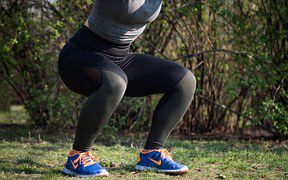
Are you dreaming of your ideal body and wishing for more muscle and less fat? Wish all you want, but that muffin top will only grow if you do not begin to eat right and exercise.
Plus, that belly roll could be visceral fat, which could cause all sorts of health problems in the future, which is why maintaining a healthy body composition is crucial for overall health and fitness.
First and foremost, achieving and maintaining a healthy body composition is key to reducing the risk of chronic diseases such as heart disease, diabetes, and certain types of cancer.
Excess body fat, especially around the abdomen, has been linked to an increased risk of these health conditions. On the other hand, having a higher proportion of lean muscle mass can contribute to improved metabolic health, better insulin sensitivity, and a more efficient metabolism.
In addition to disease prevention, a healthy body composition plays a significant role in enhancing physical performance and functional abilities. Having a higher muscle mass and lower body fat percentage can improve your strength, endurance, and overall athletic performance.
Whether you’re engaging in sports, recreational activities, or simply performing day-to-day tasks, maintaining a healthy body composition allows you to move more efficiently and with greater ease.
Beyond the physical benefits, achieving a healthy body composition positively impacts your mental and emotional well-being. When you feel confident in your body and are physically fit, it boosts your self-esteem and self-image.
This can lead to increased motivation, improved mood, and a greater sense of overall well-being. Taking care of your body composition can contribute to a positive body image and a healthier relationship with yourself.
Remember, achieving a healthy body composition is not solely about losing weight or reaching a specific number on the scale. It’s about finding the right balance between muscle mass and body fat that suits your individual needs and goals. This may involve strength training exercises to build lean muscle, adopting a well-rounded and balanced diet, and engaging in regular physical activity that includes both cardiovascular exercise and resistance training.
So, let’s get into it.
Resistance Training for Muscle Building
Resistance training is an essential component of building lean muscle mass and achieving a healthy body composition. Let’s delve into the benefits of resistance training, how it stimulates muscle growth, and some effective exercises and techniques to incorporate into your fitness routine.
Benefits of Resistance Training: 
- Resistance training offers numerous benefits for muscle building and overall health. Firstly, it helps to increase muscle strength and endurance, allowing you to perform daily activities with ease and reduce the risk of injuries. Additionally, resistance training promotes bone density, improving your skeletal health and reducing the risk of osteoporosis.
Muscle Growth and Increased Metabolism:
- Engaging in resistance exercises stimulates muscle growth through a process called hypertrophy. When you challenge your muscles with resistance, it creates microscopic damage to the muscle fibers. As your body repairs and rebuilds these fibers, they become stronger and larger, resulting in muscle growth.
Moreover, resistance training plays a significant role in boosting your metabolism. Unlike cardio exercises that primarily burn calories during the workout, resistance exercises help build lean muscle mass, which is metabolically active tissue. This means that even at rest, your muscles burn more calories compared to fat tissue. By increasing your muscle mass through resistance training, you enhance your metabolic rate and promote fat burning.
Effective Resistance Training Exercises and Techniques:
- There are various resistance training exercises and techniques you can incorporate into your workouts to build lean muscle mass. Here are a few examples:
- Compound exercises: Compound exercises target multiple muscle groups simultaneously, maximizing muscle activation and growth. Examples include squats, deadlifts, bench presses, and rows.
- Resistance machines: These machines provide controlled resistance and are suitable for beginners or individuals targeting specific muscle groups. Leg press, chest press, lat pulldown, and leg curl machines are common examples.
- Free weights: Dumbbells, barbells, and kettlebells offer a versatile range of exercises that engage stabilizer muscles and promote functional strength. Exercises like bicep curls, shoulder presses, lunges, and kettlebell swings are effective for muscle building.
- Bodyweight exercises: These exercises utilize your body weight as resistance and can be done anywhere. Push-ups, squats, lunges, planks, and pull-ups are excellent examples of bodyweight exercises that promote muscle growth.
- Progressive overload: To continue challenging your muscles and promoting growth, gradually increase the intensity, weight, or resistance over time. This progressive overload stimulates muscle adaptation and prevents plateaus.
 Incorporating resistance training into your fitness routine a few times a week can yield significant improvements in muscle strength, endurance, and overall body composition. Consult with a qualified fitness professional to design a personalized resistance training program that suits your goals and fitness level.
Incorporating resistance training into your fitness routine a few times a week can yield significant improvements in muscle strength, endurance, and overall body composition. Consult with a qualified fitness professional to design a personalized resistance training program that suits your goals and fitness level.
By embracing resistance training and consistently incorporating effective exercises and techniques into your workouts, you can build lean muscle mass, boost your metabolism, and achieve a balanced and healthy body composition.
Proper Nutrition for Muscle Building and Fat Loss
 Nutrition plays a crucial role in supporting muscle growth and reducing body fat. To maximize your results and achieve optimal body composition, it’s essential to understand the significance of nutrition and how it affects your muscle-building and fat loss goals. Let’s explore the key aspects of nutrition for muscle building and at loss.
Nutrition plays a crucial role in supporting muscle growth and reducing body fat. To maximize your results and achieve optimal body composition, it’s essential to understand the significance of nutrition and how it affects your muscle-building and fat loss goals. Let’s explore the key aspects of nutrition for muscle building and at loss.
Significance of Nutrition:
Nutrition provides the necessary building blocks and energy for muscle repair, growth, and overall functioning of the body. It directly impacts your ability to build lean muscle mass and lose excess body fat. By fueling your body with the right nutrients, you can optimize your muscle-building potential and promote fat loss.
Adequate Protein Intake:
Protein is a vital nutrient for muscle repair, growth, and maintenance. Consuming adequate protein supports muscle protein synthesis, the process responsible for building and repairing muscle fibers. Aim to include high-quality protein sources in your diet, such as lean meats, poultry, fish, dairy products, eggs, legumes, and plant-based protein sources like tofu and tempeh.
Balanced Macronutrients and Calorie Control:
Achieving optimal body composition requires a balance of macronutrients – protein, carbohydrates, and fats – and managing calorie intake. Carbohydrates provide energy for workouts and replenish glycogen stores, while fats are essential for hormone production and overall health. Opt for complex carbohydrates like whole grains, fruits, and vegetables, and choose healthy fats from sources such as nuts, seeds, avocados, and olive oil. Control your calorie intake to create a slight caloric deficit for fat loss or a slight surplus for muscle growth, depending on your goals.
Hydration and Nutrient Timing:
Proper hydration is often overlooked but crucial for optimal performance and muscle recovery. Aim to drink adequate water throughout the day, especially during workouts. Nutrient timing is also essential to support muscle building and fat loss. Consuming a balanced meal or snack with protein and carbohydrates before and after workouts can enhance muscle protein synthesis, improve recovery, and support energy levels.
Importance of Whole Foods:
While supplements can be beneficial, it’s crucial to prioritize whole, nutrient-dense foods in your diet. Whole foods provide a wide array of vitamins, minerals, fiber, and phytochemicals that support overall health and well-being. Include a variety of fruits, vegetables, whole grains, lean proteins, and healthy fats in your meals to ensure you’re getting a diverse range of nutrients.
Remember, nutrition is a key component of achieving your muscle-building and fat loss goals. By consuming adequate protein, balancing your macronutrients, controlling calories, staying hydrated, and prioritizing whole foods, you can optimize your nutrition for muscle growth and fat loss.
Cardiovascular Exercise for Fat Loss
 Cardiovascular exercise, also known as cardio or aerobic exercise, plays a significant role in promoting fat loss and improving overall cardiovascular health. Let’s delve into the details of why cardio exercise is essential for burning fat and how it can be incorporated into your fitness routine.
Cardiovascular exercise, also known as cardio or aerobic exercise, plays a significant role in promoting fat loss and improving overall cardiovascular health. Let’s delve into the details of why cardio exercise is essential for burning fat and how it can be incorporated into your fitness routine.
Promoting Fat Loss:
Cardiovascular exercise is highly effective in burning calories and promoting fat loss. Engaging in cardio activities elevates your heart rate and increases energy expenditure, which helps create a calorie deficit necessary for weight loss. Regular cardio workouts can aid in reducing overall body fat, including visceral fat that accumulates around the internal organs.
Increased Calorie Expenditure:
Cardio exercises, such as running, cycling, swimming, or brisk walking, require continuous movement and engage large muscle groups. These activities elevate your heart rate, leading to increased calorie expenditure during and after your workout. The more intense the cardio exercise, the more calories you burn. This calorie deficit contributes to fat loss over time.
Enhanced Cardiovascular Health:
Engaging in regular cardiovascular exercise improves cardiovascular health by strengthening the heart and improving lung capacity. It enhances blood circulation, lowers blood pressure, and reduces the risk of cardiovascular diseases. Cardiovascular exercise also boosts endurance, allowing you to perform daily activities with more ease and efficiency.
Effective Cardio Exercises:
There are various cardio exercises you can incorporate into your routine, depending on your preferences, fitness level, and access to equipment. Examples include running or jogging, cycling, swimming, dancing, kickboxing, and using cardio machines like treadmills or ellipticals. Choose activities that you enjoy to make your workouts more enjoyable and sustainable.
Varying Intensity Levels:
To maximize fat loss during cardio exercise, it’s beneficial to vary the intensity levels. High-intensity interval training (HIIT) involves alternating between short bursts of high-intensity exercises and recovery periods. HIIT has been shown to be particularly effective in burning calories and promoting fat loss. However, moderate-intensity continuous exercise, such as brisk walking or steady-paced cycling, can also contribute to fat burning and cardiovascular fitness.
Incorporating cardiovascular exercise into your fitness routine is an excellent strategy for promoting fat loss and improving overall health. Aim for at least 150 minutes of moderate-intensity cardio or 75 minutes of vigorous-intensity cardio each week, spread across several sessions. Remember to listen to your body, start at an appropriate intensity level, and gradually increase the duration and intensity as your fitness improves.

Remember, achieving and maintaining a healthy body composition is essential for overall health and fitness.
To help you get started I’ve listed three key factors: resistance training, proper nutrition, and cardiovascular exercise. Let’s summarize the main points and emphasize their significance in your fitness journey.
Resistance training is a powerful tool for building lean muscle mass. By engaging in resistance exercises, you stimulate muscle growth, increase metabolism, and improve overall strength and functionality. Incorporating exercises like squats, deadlifts, and bench presses into your routine can yield remarkable results.
Proper nutrition is equally vital in supporting muscle growth and reducing body fat. Adequate protein intake is crucial for muscle repair and growth, while balanced macronutrients and calorie control help optimize body composition. Remember to prioritize whole, nutrient-dense foods and maintain a well-rounded diet that fuels your workouts and promotes overall well-being.
Cardiovascular exercise plays a pivotal role in fat loss and cardiovascular health. Engaging in activities that increase your heart rate, such as running, cycling, or swimming, helps burn calories and promote fat loss. By incorporating different intensity levels and varying your cardio workouts, you can maximize results and enhance your endurance and cardiovascular fitness.
To embark on your journey towards a lean and healthy body composition, it is recommended to seek professional guidance. A certified fitness trainer or nutritionist can create a personalized plan tailored to your goals and provide the necessary support and expertise. Remember to set realistic goals, track your progress, and maintain consistency in your fitness routine.
Ultimately, achieving a lean and healthy body composition requires a holistic approach that combines resistance training, proper nutrition, and cardiovascular exercise. By incorporating these three pillars into your lifestyle, you can transform your body and improve your overall well-being. Stay committed, stay consistent, and enjoy the incredible benefits of a balanced and active lifestyle.
I encourage you to embrace the journey of achieving and maintaining a healthy body composition. Set realistic goals, seek guidance from qualified health professionals, and approach it as a long-term lifestyle commitment rather than a quick fix.
Your overall health, fitness, and well-being will thank you for prioritizing a healthy body composition.
Before starting any new exercise or nutrition program, it’s advisable to consult with a healthcare professional or certified fitness trainer to ensure it aligns with your individual needs and health status.


